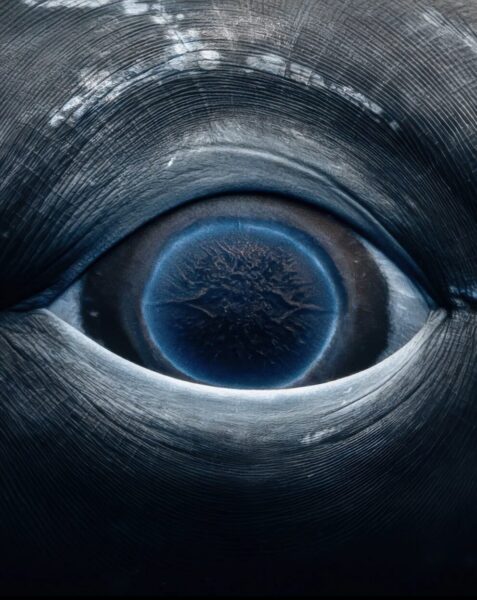While swimming with a young female humpback, photographer Rachel Moore captured an extraordinary closeup of the whale’s eye in French Polynesia.
The juvenile was gamboling around with a few spinner dolphins and seemed quite curious about the swimmers in the water. So although Moore was at the end of her shooting day, she decided to go in the water again. As soon as she did, the whale — known locally as Sweet Girl — approached her closely.
“For the next five minutes, we stared eye-to-eye at the surface, with her coming…just inches away,” recalled Moore. I zoomed in with my 16-35mm lens…and just as she rolled upside down, I pressed the shutter, capturing the last bit of sunlight illuminating her eye.
“The way she looked at me left an indelible mark on my memory,” said Moore. “It was one of the most powerful and profound moments of my life.”
The photo shows the eye in more detail than ever before. In real life, the eye was the size of a grapefruit. The image shows an electric blue ring around the pupil and the insulating fat that protects the eye.
Through no fault of the photographer, the story did not end happily. Days later, Sweet Girl died when hit by a ship.

Photo: Rachel Moore
Call for slower speeds
The Island of Mo’orea, where the photo was taken, is famous for its humpback whales. Its waters are a birthing ground for them as they journey to Antarctica. Earlier this year, Indigenous groups across Polynesia signed a historic treaty granting whales personhood. They do not see them simply as animals but as a significant part of their history and culture.
The death of Sweet Girl has prompted calls for more protection. Nearly 50,000 people have signed a petition asking for reduced ship speeds in the region.
Moore, a long-time ocean advocate, agrees and worries about many tourists’ behavior toward the ocean giants.
“Our goal should always be to respect these animals and their space, observing their behavior without disturbing it,” she says. “Whales are here to rest, mate, give birth, and nourish their young. Chasing after them only drains the energy they need during their six- to eight-month fast.
“Swimming with these majestic beings is a privilege, and respecting their space is crucial — there’s no need to chase after or force interactions. On rare occasions, whales may choose to interact on their own terms.”






